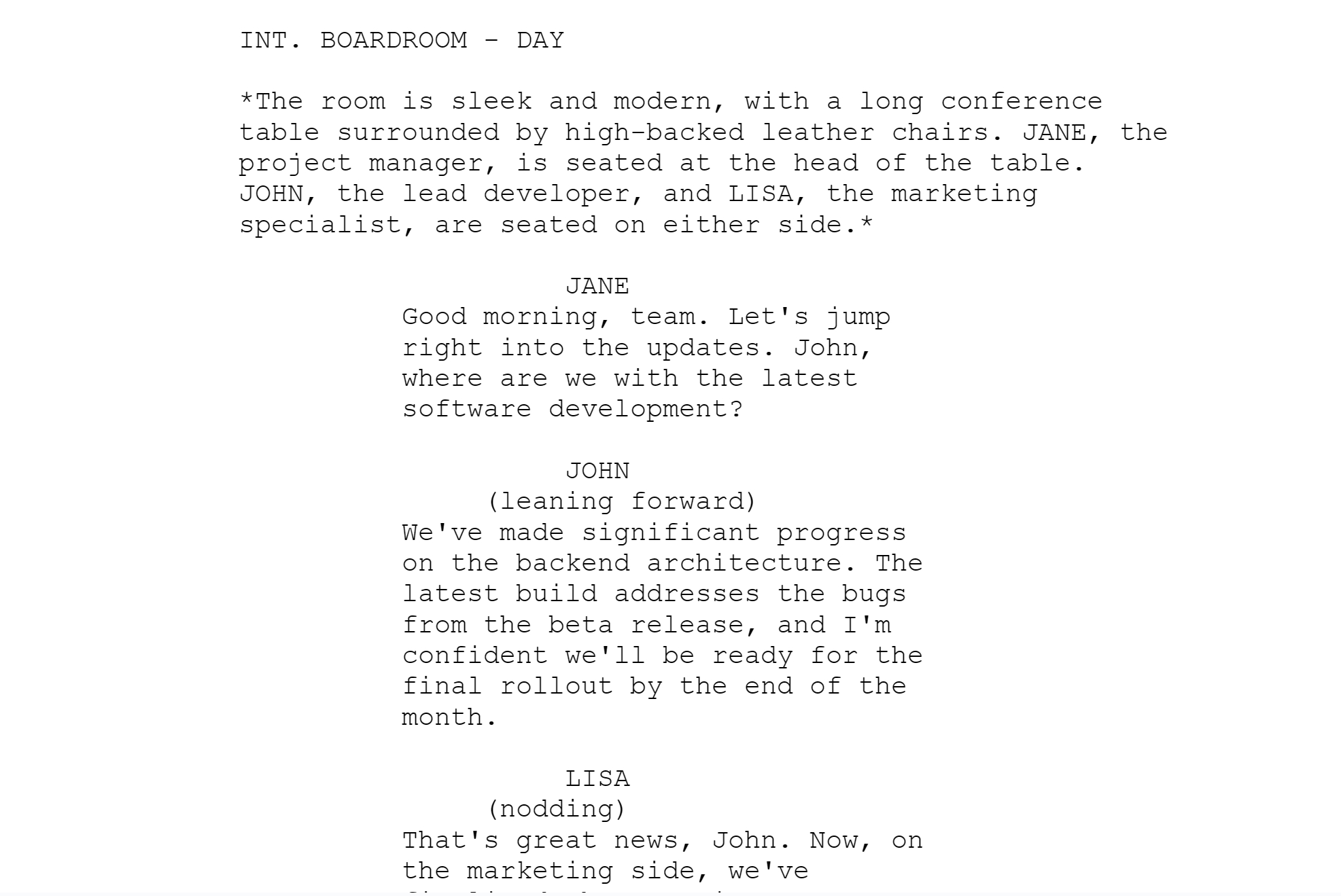Crafting a script that captivates an audience is a blend of art and science. When we shift our focus from the written word to the spoken word, the game changes entirely. This blog post is all about Scripting Success: Tips and Techniques for Writing Scripts Meant to be Spoken. Let’s dive deep into the world of scriptwriting and how to excel at it.
Understanding Scripting for the Spoken Word
The Art of Writing Spoken Content
Transitioning from writing to scripting requires an appreciation of the nuances that make spoken language powerful. When scripting, every word, pause, and inflection paints a vivid picture for the listener. Spoken language relies heavily on rhythm, intonation, and timing – aspects that may not be as prominent in written text. A successful script must sound natural when spoken, almost as if it were improvised.
Key Components of a Successful Script
- Dialogue: The heart of any script, dialogue must reflect the way people actually speak.
- Stage Directions: Often overlooked, proper stage directions inform the pacing and physical movements that convey emotion.
- Story Structure: A compelling narrative structure keeps listeners engaged from beginning to end.
- Character Development: Characters need depth and relatability to resonate with the audience.
- Conflict and Resolution: The essence of drama; presenting problems and their solutions keeps the audience invested.
A successful spoken script encompasses these elements and weaves them into a seamless listening experience.
The Role of Tone and Intonation in Speech Scripts
How something is said often carries more weight than the words themselves. The tone and intonation in a script provide depth to the characters and context to the situation. This audio dynamic plays a crucial role in how the script is received by its audience. A monotone delivery can render even the most thrilling story dull, whereas dynamic variety in pitch and stress can make even ordinary dialogue engaging.
Fundamental Writing Practices
Writing with Clarity and Precision
Short, impactful sentences often work best in speech. They are easier to follow and reduce the cognitive load on listeners. Bullet points and lists are excellent formats for ensuring content comes across clearly during a spoken delivery.
Techniques for Natural Dialogue
Natural dialogue imitates actual speech patterns. This means embracing contractions, interruptions, colloquialisms, and even the occasional grammatical imperfection if it serves to make the characters sound more realistic. People rarely speak in complete, perfectly structured sentences in real life, and effective scriptwriting should reflect this. Techniques for achieving natural dialogue include:
- Listening to real conversations: Pay attention to how people talk, including the flow, the pauses, and the informal language they use.
- Improvisation: Sometimes, acting out or verbalizing the dialogue can help writers understand how natural or contrived it may sound.
- Readability vs. performance: What reads well on paper might not translate effectively when spoken. It's essential to consider the performance aspect in the writing phase.
Structuring Your Script
Outlining Your Message
The core message of your script is your anchor. Every line should purposefully contribute toward conveying this message. Begin with a clear outline that articulates your main points. This helps to maintain focus and clarity throughout.
Traditional Script Formats to Follow
Depending on the medium – whether it be stage, screenplay, or radio – there are conventional formats that should guide your script structure. For instance, screenplays typically follow the three-act structure, while radio scripts might allow for more flexibility regarding scene descriptions.

Using Proper Script Typography and Margins
Legibility is key when a script is meant to be read and performed by actors or voice talent. The industry standards for typography and margins are in place to ensure that everyone involved in the production has a clear understanding of the text. Common typography and formatting rules include:
- Courier font: Often used for its clear distinction between letters and equal spacing.
- Margins: Standardized margins help indicate the timing of the script, with one page usually equating to one minute of screen time.
- Character Names: Placed in the center or slightly left-of-center before their dialogue, capitalized for easy identification.
Understanding and adhering to these formatting guidelines is essential for the professionalism and practical use of your script.
Engaging the Audience
Emotional Connections Through Scriptwriting
A well-written script for spoken word creates a bond between the characters and the audience. This is achieved through:
- Providing Relatable Motivations: Characters should have wants and needs that listeners can understand.
- Vulnerability and Triumph: Showcasing the weaknesses and strengths of characters to evoke empathy and cheer.
- Conflict and Resolution: Engaging your audience with challenges that keep them guessing and resolutions that satisfy their expectations.
Incorporating Storytelling Elements
Every great script has at its core a story worth telling. The age-old elements of storytelling—setting, character, plot, conflict, and theme—are crucial in scriptwriting. Here’s how you can incorporate them effectively:
-
Setting: Establish the world your characters live in. Paint a picture with your words that informs the audience's imagination. For instance, in a dystopian future where technology dominates every aspect of life, you might describe a bustling metropolis where neon lights reflect off sleek skyscrapers, conveying a sense of both awe and isolation.
-
Character: Create multi-dimensional characters with backstories, desires, and flaws. For example, instead of a generic hero, imagine a detective haunted by a past failure, seeking redemption. Develop characters like Sarah, a brilliant scientist grappling with ethical dilemmas, adding layers that engage the audience emotionally and intellectually.
-
Plot: Construct a compelling sequence of events that holds the audience's attention. In a suspense thriller, you might introduce a sudden twist, revealing the protagonist's trusted ally as the antagonist. This unexpected turn not only captivates viewers but also propels the story forward, keeping them on the edge of their seats.
-
Conflict: Introduce obstacles that characters must overcome, providing tension and intrigue. In a romantic drama, the conflict could be external, such as societal expectations keeping lovers apart, or internal, like one character's struggle with self-doubt. This conflict drives the narrative, creating emotional investment for the audience.
-
Theme: Weave a unifying concept or idea throughout the script that delivers a strong message or moral. In a coming-of-age story, the theme might revolve around the pursuit of identity and self-discovery. Through the protagonist's journey, explore themes of resilience, friendship, and the transformative power of embracing one's true self.
Developing Memorable Characters
Characters are the vessels through which the audience experiences the story. Here are some tips for developing characters that stick in the listener’s mind:
- Unique Voice: Give each character a distinct way of speaking that reflects their background and personality.
- Growth: Show how characters change over the course of the narrative.
- Relatability: Regardless of the setting, the characters’ experiences and emotions should be something the audience can connect with.
The Writing Process for Spoken Scripts
Idea Generation and Brainstorming Techniques
Crafting a compelling spoken script starts with a seed of an idea which then grows through brainstorming. Various techniques facilitate this stage:
- Mind Mapping: Visually organize thoughts and ideas to explore connections and expand on concepts.
- Freewriting: Write continuously for a set period to generate ideas without self-editing or judgment.
- Collaboration: Brainstorm with others to gain different perspectives and spark new ideas.
Drafting and Structuring Your Ideas
Once the brainstorming is done, the next step is to structure those ideas into a coherent draft. This process typically includes:
- Creating an Outline: Start with a broad framework and then fill in details.
- Building a World: Define the environment where your story will unfold.
- Developing a Beat Sheet: Break down your story into individual scenes or segments to ensure pacing and flow.
Dialogue Workshops and Table Reads
Testing your script through workshops or table reads is invaluable. They can reveal issues with dialogue that you might not notice on paper. During these sessions, listen for:
- Authenticity: Does the dialogue sound real and natural?
- Clarity: Can listeners easily follow along with the story?
- Emotional Impact: Are the the emotional beats of the script hitting as intended?
Table reads particularly give life to your script, as you hear your characters speak through the actors. This can significantly inform your revisions, enhancing the script’s realism and engagement.
Editing and Refining Your Script
The Revision Process for Scripts
Drafting is just the first phase. Editing and refining your script are where you fine-tune and elevate your work. Here are some steps for the revision process:
- Checking for consistency in characters' voice and story logic.
- Streamlining dialogue to remove redundancy.
- Ensuring pacing and rhythm suit the intended impact.
Script Editing Checklist
An effective way to approach revisions is by having a checklist. Essential checklist items may include:
- Character names and descriptions are consistent.
- Stage directions are clear and concise.
- Dialogue sounds natural and is free from clichés.
Seeking Feedback before Finalizing
Feedback from trusted colleagues, mentors, or script editors is priceless. Constructive criticism can spotlight issues you may have missed and suggest improvements. When seeking feedback:
- Be open to criticism without taking it personally.
- Look for patterns in feedback to identify areas that need work.
- Use the feedback to polish and enhance your script rather than feeling constrained by it.
Practical Tips and Techniques
Writing for Different Mediums: Podcasts, Videos, Radio
Each medium has its nuances, and understanding these will help you craft scripts that resonate with their respective audiences. For instance:
- Podcasts often allow for a more conversational tone and may include improvisation.
- Videos need a visual description but remember that not everything needs to be spoken as the imagery can tell part of the story.
- Radio scripts have to paint the picture solely with words, relying heavily on sound effects and dialogue to convey the scene.

Timing and Pacing in Scripts
The rhythm of your script is vital in maintaining attention. Here’s how you can control the pacing and timing:
- Vary Sentence Lengths: Mix short, punchy sentences with longer, more descriptive ones to create a natural flow.
- Breathing Room: Allow spaces in the script for pauses, which can emphasize points and give listeners time to absorb information.
- Action vs. Exposition: Balance the action (showing) with exposition (telling) to maintain interest.
Balancing Dialogue and Description
For scripts, striking the right balance between what characters say and what the audience sees or hears is crucial. Remember:
- Visual Elements: For video or stage, describe settings and actions briefly but vividly to complement the dialogue.
- Audio Cues: In audio mediums, use sounds and music to set the scene or communicate transitions.
Technology and Tools for Scriptwriters
Software Solutions for Scriptwriting
Utilizing the right software to facilitate scriptwriting can greatly enhance productivity and organization. Popular scriptwriting tools like Final Draft, Celtx, and Scrivener offer functionality that is specifically tailored for the formatting and structuring demands of scripting. Some features to look for include:
- Auto-formatting: To automatically apply industry-standard formatting to your scripts.
- Index Cards: For easy organization of scenes and plot points.
- Collaboration Features: To work with others in real-time or asynchronously.
Utilizing Speech-to-Text for Efficiency
For those who think faster than they type, speech-to-text technology can be a game-changer. Transcription software can capture your spoken ideas directly, which you can then refine and sculpt into a polished script. This can also help maintain the natural flow of spoken language in your writing.
Collaboration Tools for Writers’ Rooms
In many aspects of scriptwriting, collaboration is key. Online platforms like Google Docs, WritersDuet, and Storyboard That facilitate a writers' room experience even when participants are miles apart. These tools often provide real-time editing capabilities, version control, and chat functions to keep all members of the writing team on the same page. Collaboration tools ensure that:
- Multiple Voices Are Heard: They can help bring diverse perspectives to the script.
- Centralized Feedback and Revision: Everyone can see changes and suggestions in real-time, which streamlines the editing process.
Mastering the Read-Through
Conducting Effective Script Readings
Script readings or table reads are not just for actors to practice - they're a critical part of the scriptwriting process. When conducting read-throughs:
- Allocate roles to different readers to mimic the final production as closely as possible.
- Pay attention to the natural ebb and flow of the dialogue and make note of where listeners may lose engagement.
- Use the feedback immediately following the read-through to make adjustments to the script.
Interpreting Actors’ Feedback
Actors can provide invaluable insights into how dialogue can be tweaked to sound more natural or how certain lines may be delivered with greater impact. Their feedback should be:
- Seen as an opportunity to fine-tune dialogue.
- Evaluated within the context of their character development and the overall story arc.
- Considered for both its immediate practical suggestions and its broader implications for script adjustments.
Best Practices for Productivity and Creativity
Creating a Writing Schedule and Environment
Discipline is often cited as a writer's best tool for maintaining productivity. Establishing a writing schedule helps to create a routine, while a comfortable and stimulating environment can enhance creativity. Consider:
- Setting aside dedicated writing times when you’re least likely to be disturbed.
- Organizing your writing space to minimize distractions and maximize inspiration.
Overcoming Writer's Block in Scriptwriting
Writer's block is an unfortunate reality for many scriptwriters at some point in their careers. Overcoming it can involve various strategies:
- Taking a break to clear your head and gain new perspectives.
- Engaging in creative exercises or prompts that challenge you to think differently.
- Discussing your ideas with peers or mentors who can help you push past your blocks.
Scripting for Audio Versus Visual Mediums
Special Considerations for Audio Scripts
When writing scripts meant solely for auditory consumption, such as podcasts or radio plays, every description and emotion must be conveyed through sound. This involves unique techniques, such as:
- Reflecting ambient environments through carefully chosen soundscapes to evoke the setting.
- Leveraging silence and sound effects effectively to punctuate moments or imply action without visuals.
- Making dialogue descriptive when necessary, but without making it feel forced or unnatural.

Visual Storytelling Through Script Descriptions
On the other side, visual scripts for television, film, or stage need to communicate to directors and actors what viewers should be seeing. The script's descriptions play a vital role and should ideally:
- Be concise yet vivid, providing enough detail to guide the visual realization without dictating every aspect of the production.
- Use dynamic verbs to suggest motion and energy within scenes.
- Balance descriptive passages with dialogue, ensuring that visual cues support rather than overwhelm the spoken word.
Adapting Your Writing for Different Audiences
Writing Scripts for Different Demographics
It’s crucial to know your audience and tailor your script accordingly. Whether writing for children, teens, adults, or a specific niche, your scripting should align with their interests and comprehension levels. Considerations might include:
- Language appropriateness: Keeping in mind age-specific vocabulary and complexity.
- Cultural relevance: Making sure the content is relatable and respectful of the audience's cultural backgrounds and experiences.
- Theme and subject matter: Choosing topics and scenarios that will resonate with the intended demographic.
Cultural Sensitivity and Inclusivity in Scriptwriting
An inclusive script not only expands your audience but also enriches your storytelling. It involves:
- Representing diverse characters meaningfully, beyond stereotypes.
- Being mindful of cultural nuances and avoiding appropriation.
- Involving consultants or sensitivity readers when dealing with cultures or experiences outside your own.
Legal and Ethical Considerations in Scriptwriting
Copyrights, Permissions, and Fair Use
Being aware of the legal landscape is essential in scriptwriting to avoid potential infringement issues. This means:
- Understanding when you need to obtain rights for adaptations or to include certain content.
- Being familiar with the fair use doctrine and its limitations.
- Always giving due credit to original sources and collaborators.
Ethical Storytelling in Scriptwriting
Ethical considerations are just as important. They touch upon the moral responsibilities of a writer, including:
- Portrayal of violence, substance use, or sensitive topics—how it's done can have a profound impact on audiences.
- Avoiding the exploitation of real-life tragedies or traumatic events for sensationalism.
- Respecting the personal dignity of characters based on real people or who represent real groups.
Ethical storytelling involves creating narratives that are honest and thoughtful, considering the potential effects on various audience members and the broader social context.
Monetizing Your Scriptwriting Skills
Breaking into the Industry
For aspiring scriptwriters, monetizing your skills starts with breaking into the industry, which may involve:
- Crafting a strong portfolio that showcases your best work.
- Networking within the industry through events, workshops, and online forums.
- Pursuing internships or assistant positions to gain experience and make professional connections.
Networking and Pitching Tips for Scriptwriters
Networking is often about building genuine relationships rather than just transactional interactions. When it comes to pitching:
- Research and target the right people to pitch your scripts to, whether agents, producers, or directors.
- Develop a concise and compelling pitch that communicates the essence of your script and why it stands out.
- Follow up respectfully after initial pitches, and be prepared for both rejection and constructive feedback.
Conclusion
In sum, Scripting Success: Tips and Techniques for Writing Scripts Meant to be Spoken involves mastering the craft, understanding the medium, and connecting with the audience on a human level. Whether you’re scripting for podcasts or film, the key is to remain true to the spoken nature of your content, where words are not just read, but performed. Above all, remember:
- Each script is an opportunity to transport your audience into the world you've created.
- The emotional impact of your script hinges on the authenticity and relatability of your characters and dialogue.
- Your success in scripting is a journey – it will involve continuous learning, adaptation, and honing of your technique.
Embrace feedback, stay open to growth, and keep writing with the intention to share powerful, compelling stories. And when you find yourself daunted by the blank page, remind yourself that even the most experienced writers were once in your shoes – persistence is your ally.
Unlock your Recording Productivity Power with Orasyo - Try it for Free!
Supercharge your recording sessions efficiency with Orasyo, your ultimate companion that can save you a remarkable 35% of your valuable time.
Elevate your recordings to professional quality swiftly and effortlessly.
Perfect for Audiobooks, Voiceovers, and a myriad of other applications.
Cancel anytime
Additional Resources
For further study and resources, here are some recommended reads and tools to check out:
- Save the Cat! by Blake Snyder, for screen writing insights and structure.
- The Screenwriter’s Bible by David Trottier, a comprehensive guide that covers formatting, writing, and selling your screenplay.
- Online platforms like MasterClass or Udemy, which offer courses taught by industry professionals.
- Scriptwriting software reviews, to find the tool that best fits your writing style and collaboration needs.
Remember, the resources you choose to employ can greatly influence your scriptwriting process, providing structure, inspiration, and the means to refine your craft.
Final Thoughts
As we wrap up our in-depth look at Scripting Success: Tips and Techniques for Writing Scripts Meant to be Spoken, keep in mind that at the heart of every great script is a writer's passion for storytelling. Whether your stage is virtual, auditory, or physical, your scripts have the potential to engage, inspire, and move audiences. Your voice is unique, and your stories are needed. So, keep writing, revising, and reaching for success—one script at a time.




